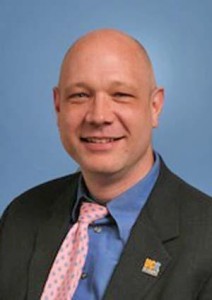 Wal-Mart announced this week that it will increase the pay of nearly 40 percent of its workforce. Starting in April, workers will earn at least $9 per hour, and wages will increase to at least $10 per hour by February 2016. With the federal minimum wage currently set at $7.25, this announcement is a welcome change for Wal-Mart’s workers, and it showcases the power of organizing. Change can happen when people band together with one voice. However, the fight is not over: $10 per hour is not enough to support a family.
Wal-Mart announced this week that it will increase the pay of nearly 40 percent of its workforce. Starting in April, workers will earn at least $9 per hour, and wages will increase to at least $10 per hour by February 2016. With the federal minimum wage currently set at $7.25, this announcement is a welcome change for Wal-Mart’s workers, and it showcases the power of organizing. Change can happen when people band together with one voice. However, the fight is not over: $10 per hour is not enough to support a family.
Roe’s Legacy is More Than Reproductive Rights
The U.S. Supreme Court case that legalized abortion in this country, Roe v. Wade is the pivotal reproductive rights case of the last century and a precious victory for women’s equality under the law. For me, though, Roe is more than legal precedent. It is a testament to the power young women can harness.
In 1972, the year the Supreme Court heard arguments in Roe v. Wade, many states still criminalized abortion. Indeed, legal access to birth control was new — it had been less than a decade since the Supreme Court overturned Connecticut’s law banning the use of contraception. You might reasonably assume that Jane Roe and her advocates would have chosen a well-known, experienced lawyer with multiple Supreme Court arguments under his — and yes, probably a “his” — belt. You’d be wrong.
Attorney Sarah Weddington was 26 years old when she appeared before the Supreme Court to argue on Jane Roe’s behalf. She was a freshly minted lawyer without significant legal experience. At the time, few women attorneys were practicing at all, much less practicing before the nation’s highest court. Weddington’s age made her the youngest Supreme Court advocate in history. The fact that she argued — and won — the groundbreaking Roe v. Wade case is just the climax of an already extraordinary story.
Dr. Paul Lyons Speaks to AAUW
The Riverside Branch of AAUW met on January 14, at 10:00 AM at Habitat for Humanity.  President Elect, Ruthann Mlcoch, (in for absent President, Barb Ryon) welcomed and thanked all those present for attending. Publication Chair, Jo Turner, introduced our speaker, Dr. Paul Lyons from UCR Medical School. Dr. Lyons’ academic resume includes a BA in Philosophy from Oberlin College, an MD from Ohio State U, a Residency in Family Medicine at Minnesota U, and the Chair of Clinical Education and faculty advisor at Temple University School of Medicine. He has received three awards for excellence in teaching and is presently Dean of Education in charge of all curricular programs and faculty recruitment for UCR Medical School.
President Elect, Ruthann Mlcoch, (in for absent President, Barb Ryon) welcomed and thanked all those present for attending. Publication Chair, Jo Turner, introduced our speaker, Dr. Paul Lyons from UCR Medical School. Dr. Lyons’ academic resume includes a BA in Philosophy from Oberlin College, an MD from Ohio State U, a Residency in Family Medicine at Minnesota U, and the Chair of Clinical Education and faculty advisor at Temple University School of Medicine. He has received three awards for excellence in teaching and is presently Dean of Education in charge of all curricular programs and faculty recruitment for UCR Medical School.
Dr. Lyons began by thanking us for the opportunity to speak about the changes that are happening at UCR Medical School. UCR is different from other Medical Schools because of its creative and innovative curriculum. UCR believes that a prerequisite for medical school is knowledge and experience in literature and the arts. Evidence has shown that this makes doctors better listeners and consequently, they can make better diagnoses. The patient seeking a doctor’s help, tells the doctor a “story,” — the doctor must then organize his/her story, the information, choose what is important and recognize the detail that doesn’t fit in. Knowing this, UCR has changed the medical school curriculum to include the Humanities. The Federal Government gave a grant of $100,000.00 for medical students to begin this new program.
First, UCR Medical School has a writing professor teaching medical students to write for the first three years of medical school. The goal for the student is to gather information and turn it into a story–(creative writing). Second, medical students are asked to make use of “pretend patients” in order to practice skills of diagnosing and human interactions. Medical students create a ten page “dramatic persona” that they use to become the simulated patients with other medical students. Third, medical students go out into the real world of practicing doctors’ offices and clinics when they are freshmen and work with patients — they continue at the same clinics for four years. Dr. Lyons calls this a Longitudinal Medical School – (we have heard this before from Chancellor Wilcox.) Thus, medical students learn to apply their skills interacting with patients from the beginning of their school career which makes for a very different medical student. Scientific competence without compassion is not the doctor you want. The feedback from doctors and staff has been positive.
Dr. Lyons believes that the community of Riverside saved the UCR Medical School. Presently, UCR Medical School has one hundred students, but the future will bring growth — in numbers of students and in the expansion by offering medical residency training at Riverside Community Hospital and other hospitals in the area.
For students wishing to enter UCR Medical School, the classic criteria of “braininess” is not the only prerequisite. UCR wants people from this region who are committed to others. They have set up an interviewing process to assess the students’ ethics, professionalism and interest in service. This is their own unique system that elicits responses from the students that can be scored by the interviewing doctor and then compared and evaluated. Dr. Lyons seemed pleased with this kind of selection of students and considers it different (better) than what other medical schools do.
Dr. Lyons is a very dynamic and engaging speaker and as a result had an avid group of listeners. Our Branch has an abiding interest in the UCR Medical School and Dr. Lyons added to our knowledge and our pride that such an institution is here. Dr. Lyons began his talk with a poem by William Carlos Williams, a verse by Dr. Seuss, and the story of Goldilocks — thus, as the saying goes, he had us from the start. (His reference to a low tech Tricoder approach to medical school, may have caused some to ponder!) Riverside and its environs are fortunate to have a person with the brains, talent and values of Dr. Lyons. What he does at UCR Medical School matters.
New College Rating System Favors UCR
The Department of Education released its outline of a federal college ratings system that aims to recognize schools which excel at enrolling students from all backgrounds, focusing on maintaining college affordability, and helping all students graduate.
As we heard from Dr. Kim Wilcox, Chancellor of UC Riverside, when he spoke to AAUW Riverside in November, UCR fits these suggested categories exceptionally well.
Low income students pay little or no tuition. UC Riverside has the highest number of Pell Grants of all California universities. As a consequence, we also have the lowest amount of student debt. If social mobility, academic quality and community service are the criteria t o rank a university, UC Riverside is ranked number one in the country by Time magazine and number two by Washington Monthly. Dr. Wilcox states that we are a great public university, and all students, regardless of gender, race or socio-economic status, graduate at the same rate. This is unusual. At last UCR is getting the recognition it so richly deserves.
o rank a university, UC Riverside is ranked number one in the country by Time magazine and number two by Washington Monthly. Dr. Wilcox states that we are a great public university, and all students, regardless of gender, race or socio-economic status, graduate at the same rate. This is unusual. At last UCR is getting the recognition it so richly deserves.
Supreme Court Hears Arguments for Pregnancy Case
 The U.S. Supreme Court recently heard arguments in Young v. UPS, a case that could affect the rights of pregnant workers across the country. Peggy Young, a UPS driver, requested temporary light-duty work as a result of pregnancy complications. Although UPS provided light-duty work to other drivers with similar restrictions, the company refused to provide the same accommodation to Young. If the court sides with UPS, it could leave pregnant workers vulnerable to discrimination in the workplace. During the arguments, AAUW and our allies led a rally in support of workplace protections. Check out our Supreme Court preview for more information on Young’s case and others awaiting the court’s decision in 2015.
The U.S. Supreme Court recently heard arguments in Young v. UPS, a case that could affect the rights of pregnant workers across the country. Peggy Young, a UPS driver, requested temporary light-duty work as a result of pregnancy complications. Although UPS provided light-duty work to other drivers with similar restrictions, the company refused to provide the same accommodation to Young. If the court sides with UPS, it could leave pregnant workers vulnerable to discrimination in the workplace. During the arguments, AAUW and our allies led a rally in support of workplace protections. Check out our Supreme Court preview for more information on Young’s case and others awaiting the court’s decision in 2015.

